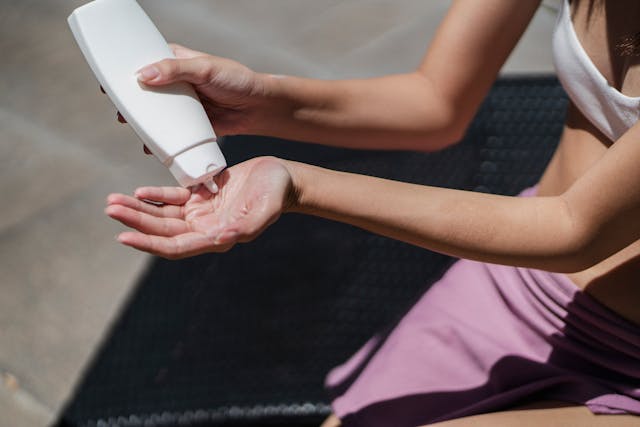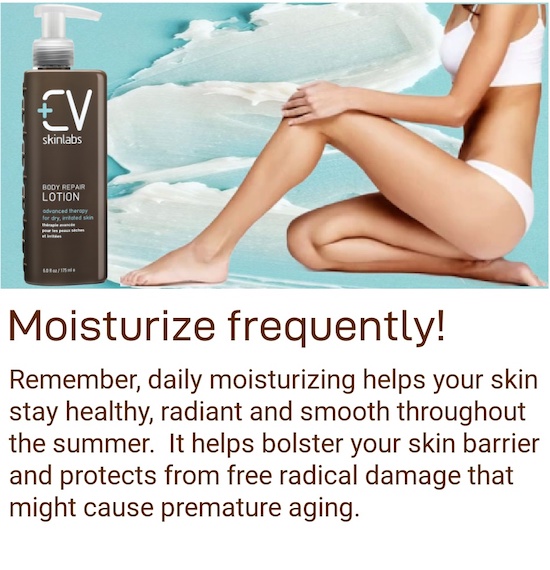It’s not hard to choose a safe self-tanner, right?
You just go to the store and pick the one that works well for you.
That’s what we all thought until recently. There’s been some information on the internet suggesting that these products may not be as safe as we thought.
Should we be concerned? We decided to dig into it.
Safe Self-Tanner: What is DHA?
Dihydroxyacetone (DHA) is the active ingredient in sunless tanning products that induces a brownish pigmentation to the skin. Chemically, it is a sugar, usually derived from beets and sugar cane. Currently, DHA is the only ingredient the FDA has approved for use in sun tanners.
How Does DHA Work?
When you apply tanning lotion to the skin, the DHA in the solution latches onto the dead cells on the surface layer. It then reacts with amino acids in the skin to form pigment products called melanoidins.
This reaction is called the Maillard reaction, which is also responsible for making the crusts of most breads brown. Amino acids and sugars react to create melanoids, and brown compounds result.

Photo by Armin Rimoldi via Pexels.
Safe Self-Tanner: Is DHA Safe to Use?
The FDA has deemed DHA safe for topical use, but they have restricted it to external application. The administration warns against applying it to the lips or any part of the body covered by mucous membranes.
In other words, the FDA hasn’t approved DHA for ingestion or inhalation. Neither has the FDA approved DHA for spray tanning or misting because of the risk of breathing it in or getting some in your nose and mouth. DHA is also not permitted for use near the eye area.
So as long as you limit your use of sunless tanners to topical applications, you should be fine, right?
Study Raises Questions About Safety of DHA
There has been some evidence that DHA may create harmful free radicals. In a 2017 study, for instance, researchers noted that an “excess” of DHA in cells “can induce advanced glycation end (AGE) products and oxidative stress.” That means that a lot of DHA in skin cells may create free radicals and AGE products, which over time, can accelerate premature aging.
The researchers took it a step further and showed that when human melanoma (skin cancer) cells were exposed to DHA, those cells were sensitive to it and displayed a burst of free radical formation within an hour. Might this suggest that exposure to DHA has toxic effects on skin cells?
An earlier study showed similar results. Scientists investigated DHA’s action on cells in the laboratory. They found that DHA harmed cells and damaged DNA. Their findings, they suggested, “raises a question about the long-term clinical consequences of treatment of the skin with this commonly used compound.”
Lucas Anthony, MD, a board-certified dermatologist based in Boca Raton, Florida, told Consumer Reports that DHA has been shown to cause an increase of free radicals in the skin.
“This can contribute to skin aging as the free radicals break down collagen and elastin in skin, which leads to wrinkling and skin aging.”
She went on to say, though, that it’s unlikely the aging effect would be pronounced. DHA mostly reacts with the top layers of the skin, which contain dead skin cells. It’s in the deeper layers of skin where we’re more concerned about excessive free radicals damaging collagen and elastin.
We need more studies to sort this out. So far, most have been done in the laboratory—not on actual human beings. But the results do suggest a need for caution moving forward.
Safe Self-Tanner: How to Be Safe When Using Sunless Tanner
To ensure that you’re enjoying a safe tan for summer, follow these recommendations.
1. Avoid Mucous Membranes
DHA should not be applied near the eyes, lips, or nose. It may be dangerous if inhaled or ingested. That means you need to use extra caution with spray and misted tanners. It may be safest to avoid these entirely and stick to lotions, gels, and drops.
If you do use sprays or mists, be sure to protect your eyes, nose, and mouth. If you get a spray tan, if you can, wear a mask. Pregnant women and people with asthma should be particularly cautious.
2. Read the Labels
DHA isn’t the only ingredient that you should be careful of in self-tanning products. Some also contain toxic ingredients like parabens, sulfates, and artificial fragrances. Look for “clean” products that use only safe ingredients. If you have sensitive skin or allergies, use only the natural DHA and fragrance-free options.
3. Perform a Patch Test
It’s always best to do a patch test on a small area of skin anytime you’re trying a new self-tanner of any kind. You want to be sure that you’re not sensitive or allergic to it before you apply it all over your body. If you have reactive skin or an allergy to DHA—the active in most self-tanning products—you will likely see a red, itchy rash and should avoid self-tanning.
4. Use Sun Protection
Many people are under the false impression that because a fake tan makes the skin darker, that somehow that gives the skin increased resistance to harmful ultraviolet rays from the sun.
The opposite is actually true. In a 2008 study, scientists found that the reaction that DHA creates in the skin generated free radicals during UV irradiation. In other words, sun exposure induced the formation of free radicals. The scientists found that in DHA-treated skin, more than 180 percent additional radicals were generated during sun exposure when compared to untreated skin.
That means that after using self-tanner, it’s even more important to protect your skin from the sun. Use a safe sunscreen with an SPF of 30 or more.
5. Take Good Care of Your Skin Before and After Tanning
Daily skin care can help increase the odds that your skin stays healthy, radiant, and smooth throughout the summer. It also increases your skin’s resistance to damage. Plus, hydrated skin helps self-tanners perform better and maintains a tan longer than dry, thirsty skin.
Regularly cleanse, tone, and moisturize with chemical-free, ph-balanced, breathable moisturizers like our Calming Moisture and Body Repair Lotion. They will hydrate, nourish and replenish skin while strengthening and protecting the skin barrier. It’s also important to protect from the sun and nourish your skin from the inside out with healthy foods and plenty of water.
Experts advise waiting to apply moisturizers immediately after getting a spray tan or applying a self-tanner until after the first shower, but after that you should start to moisturize. Moisturizing after a self-tan helps maintain that sun-kissed radiant glow and prevents skin from free-radical damage that leads to skin aging.
Aloe-based Rescue & Relief Spray provides soothing moisture and helps balance skin head-to-toe.
Self-Tanners Remain the Safest Option
Many of us have turned to self-tanners to avoid the potential danger that comes with tanning our skin in the sun or a tanning booth. From what we know so far, self-tanners are safer than tanning beds and excessive sun exposure. (Tanning beds are the most dangerous when it comes to damaging the skin as they emit more UVA light than natural sunlight does.)
It may be wise to take some precautions, however, such as those listed above. You may also want to give your skin a break now and then. Perhaps through the winter when you’re wearing more clothes you can cease your use of self-tanner until the warmer months come around.
How do you choose a safe self-tanner?
Featured image by Armin Rimoldi via Pexels.




